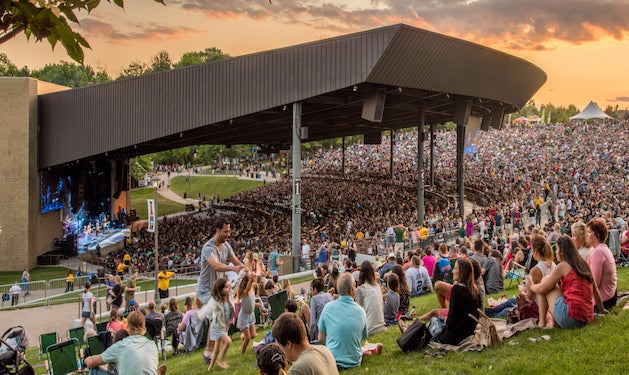Creedence Clearwater Revival: 50 Years of Peace & Music
It was impossible to avoid hearing Creedence Clearwater Revival on the radio in the summer of 1969, and many in attendance at Woodstock recall the band’s performance late in the night of the Saturday/early Sunday performances as among the best of the festival.
Day Two, Performer 10: Creedence Clearwater Revival
Performed Sunday morning, August 17, 1:00–1:50 am

John Fogerty and Doug "Cosmo" Clifford of Creedence Clearwater Revival on stage at Woodstock (not pictured: Stu Cook and Tom Fogerty). Photo © Elliott Landy
Creedence Clearwater Revival Band Members
- John Fogerty: vocals, guitar, harmonica, piano
- Tom Fogerty: guitar, vocals
- Stu Cook: bass
- Doug "Cosmo" Clifford: drums
Creedence Clearwater Revival Woodstock Setlist
- Born on the Bayou
- Green River
- Ninety-Nine and a Half (Won't Do)
- Bootleg
- Commotion
- Bad Moon Rising
- Proud Mary
- I Put a Spell on You
- The Night Time is the Right Time
- Keep On Chooglin’
- Suzie Q
Guitarist/vocalist/songwriter John Fogerty, drummer Doug Clifford and bassist Stu Cook met in high school in the San Francisco Bay Area town of El Cerrito, California in the early 1960s and played covers of popular songs as The Blue Velvets. John’s older brother, Tom, joined the group on rhythm guitar, and a record executive renamed the group the Golliwogs. A stint in the Army Reserve for John and the U.S. Coast Guard Reserve for Doug derailed the fledgling band until 1968, when Fogerty was discharged. The band re-grouped to record a full-length album, again changing their name. They chose the name Creedence Clearwater Revival, supposedly to honor Tom’s friend Credence Newball, echoing the clear water phrase from an Olympia beer advertisement, and to signify the band’s renewed commitment.

Revival (1968)
In 1968, Creedence Clearwater Revival’s first, self-titled album featured a remake of Dale Hawkins’ 1956 song, “Susie Q,” which was their first of many Top 40 hits. Most of 1968 was spent touring, CCR’s high-intensity live shows whipping audiences into a frenzy from coast to coast. A second album, Bayou Country, cemented their success and spawned a massive hit single in the form of the classic, “Proud Mary.” A mere two months after the release of that album, the band was back in the studio recording their third studio album. Released two weeks before Woodstock,Green River brought yet more huge hit singles with “Bad Moon Rising.” “Lodi,” and the title track. As John Fogerty would later put it, Creedence truly was the “hottest shot on Earth” as the band took the stage at Woodstock.

The audience was familiar with Bayou Country and Green River
as they took the Woodstock stage
Creedence blasted open their set with “Born On The Bayou” from their second album Bayou Country. This was followed by the title track from their just-released album Green River, which had also been a sizeable U.S. hit (climbing to #2 in the Billboard chart). Dipping back into their first self-titled album released the year before, next up was a cover of Wilson Pickett’s “Ninety-Nine And A Half (Won’t Do).”
“Bootleg” (from Bayou Country) and “Commotion” (from Green River) followed before the band whipped out two major hit singles in a row. “Bad Moon Rising” had been a #2 hit in the spring before being included on the Green River album, and “Proud Mary” was not only a #2 hit earlier in the year (taken from Bayou Country), but would go on to become arguably the band’s most enduring classic song (helped greatly by a frenzied cover by Ike and Tina Turner). A cover of Screaming Jay Hawkins’ “I Put A Spell On You” (which had been released on the group’s debut album) brought the proceedings back down to earth a bit, and the band delivered a harmony-rich cover of Nappy Brown’s “The Night Time Is The Right Time” (released on Green River) before ending the main set with a knock-’em-dead version of the final track from Bayou Country, “Keep On Chooglin’.” Called back for an inevitable encore, the band delivered an equally extended and stunning version of their first hit single, a cover of Dale Hawkins’ “Suzie Q” that they had recorded for their 1968 debut album.
Unfortunately, John Fogerty was not happy with Creedence Clearwater Revival’s Woodstock performance, insisting that the other members were sluggish and that the audience was not responding (he blamed this on Grateful Dead, who he accused of putting the audience to sleep!). Other band members remembered their set differently, claiming that their performance was classic Creedence. They played all their hits and turned in a solid performance that those who witnessed it remember to this day. Unfortunately, John Fogerty’s disappointment led to his refusal to allow any of Creedence’s set in the Woodstock movie or the soundtrack, leading many to think the band did not perform at the festival.
But Creedence had other problems. Brothers John and Tom Fogerty grew further apart, and Tom left the group over creative differences in 1970 and died in 1990 of AIDS that he had contracted from a blood transfusion. Creedence continued as a trio for a time, releasing several more albums, having more hits, and touring extensively. The band broke up in 1972, amid in-fighting between John Fogerty and the other two remaining members. Stu Cook and Doug Clifford played with various other musicians, reuniting in 1995 as Creedence Clearwater Reunion, without John Fogerty.
After the band broke up, Fogerty pursued a solo career, refusing to play any Creedence Clearwater Revival songs until 1987, at the urging of Bob Dylan and George Harrison. He dropped from public view again in the late 1980s but returned with the Grammy-winning Blue Moon Swamp in 1997. He still tours frequently, playing Creedence classics and new material.
—Wade Lawrence & Scott Parker
